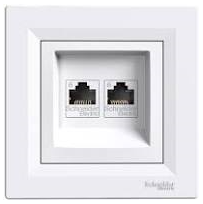Wired network
Atualizado/Updated: 2024-07-24

The wired network service allows access to the network through iscte’s physical data infrastructure. This access is for terminal equipment only, and no connection of network equipment or similar equipment is authorized.
-
- In the common spaces (classrooms, auditoriums, laboratories and study rooms) just connect the computer to the data network socket.
- In other spaces (enclosures and services), it is necessary to request the registration of the physical address (mac-address) of the network card of the personal computer.
-
- Sign in to “iAjuda.”
- Click “NEW ORDER“.
- Choose the category “Networks, Internet and Communications“.
- Choose the sub-caregoria “Cable network“.
- Choose “Register Mac Address“.
- Preenher the form indicating macaddress in the format “xx:xx:xx:xx:xx:xx“.
- Press “Next.”
- Click “OK“.
Tip: The physical address of the network card (mac-address) that is defaulted will be the one that you can use to access the wired network.
Windows 10 environment
-
-
- In the lower left corner, press the “Start/Start” button.
- Choose the “Settings/Settings” option.
- Choose the “Network & Internet” option.
- Choose the “View Network Properties” option.
- Copy the “Phisical address (MAC):” (xx:xx:xx:xx:xx:xx).
-
MacOS environment
-
-
- In the upper right corner, click on the magnifying glass (spolight) and write “network utility“.
- Click “Network Interface“.
- Choose ” Network Interface (en0)” corresponding to the wired network card.
- Copy the “Hardware Address” (xx:xx:xx:xx:xx:xx).
-
Linux environment
-
-
- Open the “Terminal“. To do this, in the main menu, go to “System Tools” and click on “Terminal“. Alternatively, look under “Accessories” (in the main menu).
- To check which interface the wired network card matches, write the command “iwconfig” in the “Terminal“.
Tip: The wired network card interface is the one that has the indication “no wireless extensions“. Note that if there is more than one wired network card, there will be more than one interface with the indication “no wireless extensions“. - To view the mac-address of a particular network card, enter the command “ifconfig XXX” ( where XXX corresponds to the interface of the network card for which you want to see the mac-address).
-
